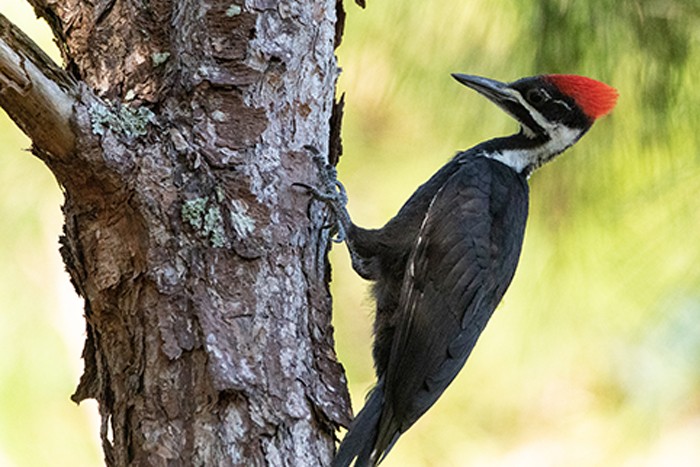Discovering Woodpeckers in Florida: Species Diversity and Natural History
Discovering Woodpeckers in Florida: Species Diversity and Natural History
Blog Article
Revealing the Secrets of Woodpeckers: Actions, Habitat, and Much More
Woodpeckers, with their one-of-a-kind habits and specialized adaptations, have lengthy captivated scientists and nature lovers alike. These impressive birds have a series of interesting secrets that shed light on their survival strategies, environment preferences, and detailed interaction methods. By discovering the secrets bordering woodpeckers' habits and habitat choices, a deeper understanding of these avian wonders arises, offering a glimpse into their fascinating world. What makes these birds truly outstanding, and just how do they browse their atmosphere with such precision and skill? Allow's check out the exciting realm of woodpeckers and untangle the enigmatic information that make them such appealing subjects of research study.
Woodpecker Behavior Insights
In analyzing woodpecker actions, an interesting display of specialized abilities and adaptations emerges, shedding light on their remarkable ecological niche. Woodpeckers, recognized for their distinct drumming on trees, possess a range of behavior characteristics that add to their survival and success in their atmosphere.
In addition, woodpeckers exhibit a distinct feeding behavior characterized by their capacity to essence pests from tree bark utilizing their specialized beaks. Their lengthy, barbed tongues aid in recording victim, while their solid neck muscular tissues provide stability and accuracy throughout pecking activities. This feeding method allows woodpeckers to gain access to hidden insect larvae and extract them with exceptional effectiveness.
Habitat Preferences and Choice
What aspects influence the environment preferences and selection of woodpeckers? One crucial aspect influencing woodpecker environment choice is the schedule of suitable nesting websites. Woodpeckers normally choose forests with a mix of mature trees that give sufficient opportunities for cavity excavation.
Furthermore, woodpeckers reveal a preference for environments with a plentiful supply of food sources. They are mostly insectivorous, feeding upon beetles, ants, larvae, and various other bugs located in rotting timber or tree bark. Woodpeckers tend to prefer woody locations with a varied insect populace to meet their nutritional needs.
Additionally, the presence of dead or worn out trees is another essential variable in woodpecker environment choice. These trees not just offer food resources but additionally provide appropriate substrate for tooth cavity excavation. Dead trees are necessary for the upkeep of healthy and balanced woodpecker populaces, as they play an essential duty in the woodpeckers' life process and ecosystem dynamics.
Feeding Practices and Diet Plan Make-up
Woodpeckers show a specialized feeding actions concentrated on foraging for insects within various habitats. Their diet mainly contains bugs such as beetles, ants, caterpillars, and spiders, which they locate by touching on tree bark and paying attention for the audio of movement inside. Woodpeckers use their strong beaks to drill right into the timber and their lengthy, barbed tongues to remove target from gaps. In addition to pests, woodpeckers also consume tree sap, fruits, nuts, and seeds, including selection to their diet plan depending upon the period and availability of food resources.
The foraging techniques of woodpeckers are well-adapted to their arboreal lifestyle. Woodpeckers play a crucial duty in preserving the health of woodlands by regulating insect populations and helping in the disintegration of wood.
Drumming Sounds and Interaction
Utilizing fast drumming noises on various surface areas, woodpeckers utilize a distinctive kind of communication to signify area boundaries and bring in companions. This drumming behavior is not just a means of interaction however additionally offers as a see this here way for woodpeckers to develop their presence within a certain area. The strength, speed, and pattern of the drumming can communicate vital info to other woodpeckers in the area.
Woodpeckers use drumming audios to reveal their existence in an area and to caution off prospective trespassers. The loud and repetitive nature of the drumming works as a clear signal to other woodpeckers that the area is already declared. This aids in minimizing conflicts and lessening physical confrontations in between people.

Survival Adaptations and Specialized Anatomy

Final Thought
To conclude, woodpeckers show unique behaviors, such as drumming audios for communication, and have actually specialized composition for survival in their selected environments. Their feeding routines and diet make-up additionally demonstrate their flexibility to different environments. By recognizing these elements of woodpeckers, scientists and guardians can better secure and preserve these interesting birds and their ecosystems.
Report this page